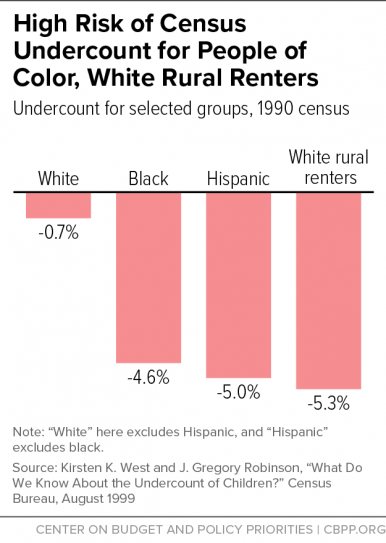February 14, 2019
Let’s Make Sure the Census Counts Every Virginian
Equal representation in Congress, the state legislature, and county board of supervisors. Funding for schools, highways, and healthcare. All this and more is at risk if the 2020 Census does not achieve a full and fair count of Virginia residents, and the federal government isn’t doing its part this time around to provide funding for outreach and follow-up in hard-to-count communities. With the 2020 Census only a year away, this year’s budget amendments are the last opportunity to get any state funding to make up for the lack of federal resources. Unfortunately, both the the state Senate and House eliminated the modest $1.5 million that was included in the introduced budget for Census outreach in Virginia.
We can’t just assume that the federal government will do enough and that it will all work out. Even in 2010, when more federal resources were provided, non-Hispanic white residents were overcounted nationally, while Black and Hispanic residents were undercounted. With the federal Census funding levels at very low levels, the 2020 results may look more like the 1990 Census undercounts, when nationally 5 percent of Latinx and Black residents were undercounted, compared to 1 percent of non-Hispanic white residents.
And as a new report from the Census Bureau shows, communities of color and immigrants are particularly at risk of being undercounted in 2020. Only 55 percent of Asian American survey respondents said they were “extremely” or “very” likely to fill out the Census form, compared to 64 percent of Black respondents, 65 percent of Latinx respondents, and 69 percent of non-Hispanic white respondents. Sixty-three percent of foreign-born respondents said that they are very or extremely likely to fill out the form, compared to 68 percent of U.S.-born respondents. The low planned response rates among Asian Americans and foreign-born respondents may be the result of high levels of fear that Census responses will be used against them and a reported lack of familiarity with the Census. And the planned addition of a citizenship question for all respondents to the Decennial Census is likely to complicate matters more.
Low-income communities and rural communities are also at risk of being undercounted, with over 5 percent of rural white renters undercounted in 1990. With the Census moving to primarily digital responses for 2020, undercounts may be even worse in rural areas with unreliable internet access.

An undercount would have major implications for equal representation and federal funding that helps boost low-income communities. The problem is so acute that the National Association for the Advancement of Colored People (NAACP) is suing the federal government over the lack of Census funding.
Meanwhile, here in Virginia, people of color and immigrants are particularly likely to live in hard-to-count neighborhoods (those Census tracts where fewer than 73 percent of respondents mailed back responses in 2010). While just 7 percent of non-Hispanic white Virginians live in hard-to-count neighborhoods, 17 percent of non-Hispanic Black Virginians, 18 percent of non-Hispanic Asian American and Pacific Islander Virginians, and 28 percent of Hispanic Virginians live in hard-to-count neighborhoods. And 24 percent of all foreign-born Virginians live in hard-to-count neighborhoods. (The Leadership Conference for Civil and Human Rights provides similar estimates for every state based on prior-year data, along with further explanations of the barriers to achieving a full and fair Census count for America’s diverse communities, including Latinx, American Indian/Alaska Native, Asian, Native Hawaiian, and Pacific Islander, and Black communities, as well as young children.) This matters because if you live in a neighborhood where your neighbors are undercounted in the 2020 Census, you and your neighbors will not get fair representation when legislative and congressional districts are redistricted using the 2020 Census data.
Making sure all Virginians have access to equal representation in all levels of government is the most important reason Virginia needs a full and fair count. But adequate funding for public services is also at stake. An accurate count is necessary to determine appropriate funding levels for states and localities, so that they can provide high-quality public services at a reasonable cost to taxpayers. Virginia received over $5 billion in federal aid during fiscal year 2015 alone for 11 federal-state partnerships for which funding levels are influenced by Decennial Census data. That includes almost $1 billion in federal highway funding and $234 million of Title I funding for public schools.
Many states are stepping up to fill this gap by providing their own funding for Census outreach, and it is vital for Virginia to do so to in order to get a fair count of our community members, particularly in communities of color and rural areas that are hard to reach. A national study estimates that Virginia needs over $13 million for Census outreach work to make sure we get the most full and fair count possible. Removing the modest $1.5 million that was included in the introduced budget moves Virginia in the wrong direction.
Virginia’s House and Senate conferees have the opportunity to reduce the expected Census undercount and make sure every Virginian is counted, including Virginia’s communities of color and immigrant communities that are most at risk of being left out. It may seem like a heavy lift because both the House and Senate removed it, but given all that’s at stake, retaining the $1.5 million that was in the introduced budget is the least they should do.
Voices for Virginia’s Children has set up a tool to make it easy to contact your legislator on this important issue if they are on the House Appropriations or Senate Finance committees. Click here: bit.ly/VaKids-Census
Category:
Economic Opportunity
